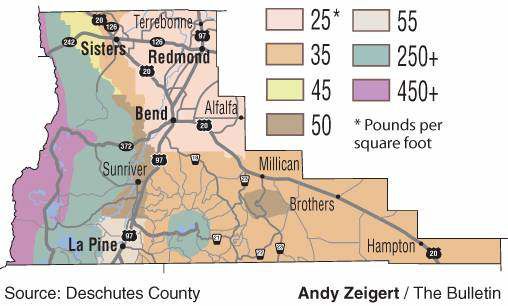Can your roof bear the load?
Published 4:00 am Thursday, January 31, 2008

- Can your roof bear the load?
During the course of a normal January in Central Oregon, 8.6 inches of snow will fall on a Bend roof.
But only 4.5 inches will fall on Redmond houses and businesses, while 2.84 inches will fall on those in Prineville.
Throughout Deschutes County and the state, those roofs have to be built to different standards to withstand different amounts of snow.
In snowier areas, builders have to use different materials and different designs to make sturdier roofs, so as a result buildings in La Pine must be able to hold up twice the weight as buildings in Bend.
And while Oregon building codes have called for snow load requirements since 1973, Deschutes County has more specific standards based on elevation.
“It’s taken a lot of studies, how we come up with the actual (snow) load that we determine,” said Dan Horton, supervisory building plan examiner with the Deschutes County building safety division.
He and another county staffer used three different surveys, including one that the Forest Service conducted of the amounts of snowfall throughout the region, and came up with a map that takes into consideration elevation, forested areas and open range to figure out how much snow roofs should be able to support.
“We got down to the nitty-gritty,” Horton said.
Crook and Jefferson
In Crook County, there’s one cutoff: Roofs on buildings constructed below an elevation of 4,000 feet need to withstand 25 pounds per square foot; those above 4,100 have to withstand 50 pounds per square foot or be specially designed. In Jefferson County, construction in all areas but Camp Sherman and Suttle Lake must meet the 25 pounds per square foot level.
How much snow that converts to varies a lot depending on how wet the snow is, said Mike Roberts, Jefferson County building official. And that also makes it difficult to tell when people should be concerned about the amount of snow building up on their roofs, he said.
But in general, if different layers of compounded snow build up, it might be time to shovel off the roof, he said.
Before building a new roof, however, builders can use the maps and standards to determine the requirements, Horton said. The lowest requirements are in Bend, Redmond and areas east of those towns. Buildings in the Paulina Lake area or along Skyliners Road west of Bend, however, are among those that need to have roofs strong enough to handle significantly more snow.
“A lot of times, roofs have failed because they did not have substantial structural strength to lift the load,” Horton said.
Many of the problems come with manufactured homes, he said, since the county has no requirements for those. Instead, manufactured homes only have to adhere to the U.S. Department of Housing and Urban Development standards, he said, and those can be less than the area-specific regulations.
Multilevel roofs
Roofs with multiple levels can also have problems, he said, if a bunch of snow builds up on an upper level and then slams down on a lower level.
To meet the snowier standards, builders can use different sizes of rafters at different spacings, he said.
They can also engineer the roof’s trusses in specific ways, using different lumber grades and different ways of attaching rafters to the house, said Doug Watson, manager of Backstrom Builders Center.
“They’re overbuilt by quite a bit so that they will take a snow load,” Watson said.
A well-designed roof should be able to withstand the snow, said David Fishel, owner of Glacier Design and Engineering in Bend.
A wooden roof that isn’t holding up well under the snow could show signs such as sagging before it fails, he said, or homeowners might notice cracks changing shape or doors and windows that won’t open in snowy conditions.
Homes built since the snow-loading code went into effect in the early ’70s should be able to withstand the snowfall, Horton said. But people can still check to see if their roofs are strong enough by either having a designer, inspector or other professional make the calculation, or calling the company that manufactured the trusses.
People constructing new buildings can also contact Horton’s office to make sure their plans are adequate, he said.
But snow isn’t the only thing roofs are designed for, Horton added, listing off wind loads and the load of the building material itself.
“You’ve got a lot of criteria to look at for safety,” he said.






